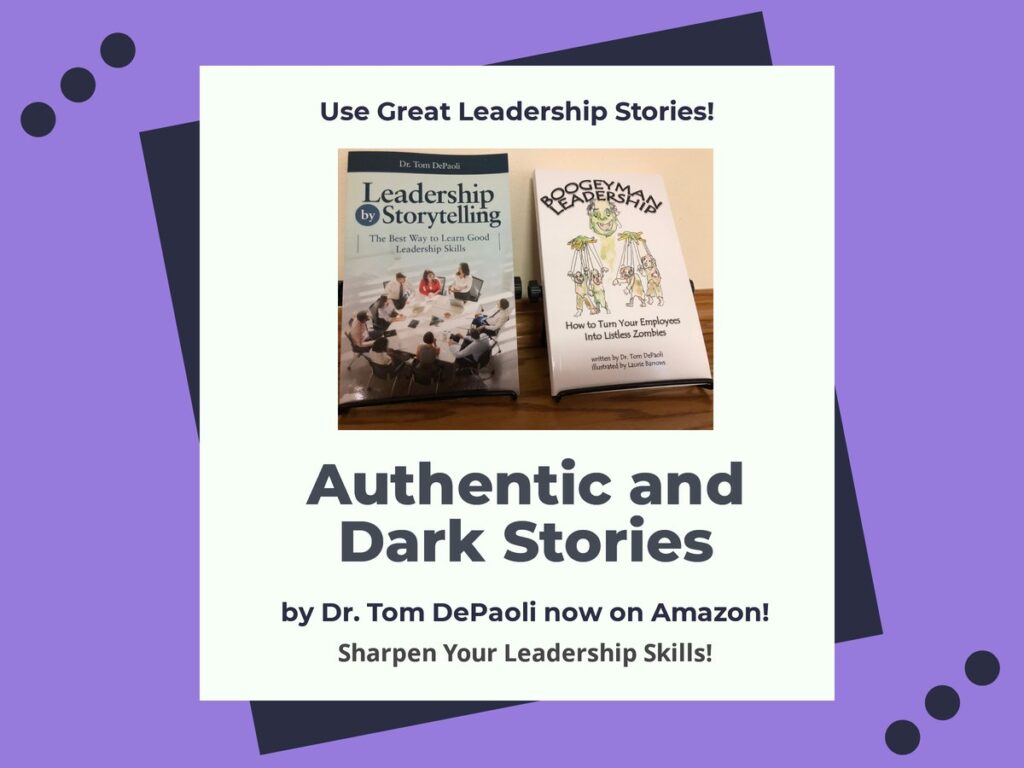In the realm of leadership literature, Dr. Tom DePaoli has emerged as a distinguished voice, offering unique insights and perspectives that challenge conventional notions of effective leadership. With his two seminal books, Leadership by Storytelling and Boogeyman Leadership, Dr. DePaoli presents contrasting yet complementary approaches to leadership, each with its own set of principles that can transform the way leaders guide and inspire their teams.

Dr. Tom DePaoli: A Trailblazer in Leadership Thought
Before we dive into the intricacies of his two leadership books, it’s crucial to understand the foundational ethos that Dr. DePaoli brings to his work. With extensive experience in the fields of purchasing, supply management, and business consulting, Dr. DePaoli’s insights are grounded in a deep understanding of organizational dynamics and human behavior. This wealth of knowledge serves as the backdrop against which his principles of leadership are illuminated.
Leadership by Storytelling : Inspiring Through Narratives
In his book Leadership by Storytelling, Dr. DePaoli advocates for the power of storytelling as a means of effective leadership communication. He draws upon the age-old tradition of storytelling to convey complex messages, inspire action, and foster a strong sense of connection within teams. Dr. DePaoli’s book is a guide to crafting and delivering impactful narratives that resonate with team members’ emotions, values, and aspirations. The principles of Leadership by Storytelling include:
- Emotion-Driven Communication: Dr. DePaoli emphasizes that stories have the potential to evoke powerful emotions that resonate deeply with individuals. Leaders who harness this power can create an emotional bond with their team members, fostering a sense of unity and shared purpose.
- Contextual Understanding: Through stories, leaders can provide context and perspective that help team members understand the bigger picture. By weaving narratives that highlight the significance of their roles, leaders enable employees to see the direct impact of their contributions.
- Values-Based Leadership: Stories can convey an organization’s values, mission, and culture in a compelling and relatable manner. Leaders who share stories that align with these values inspire their teams to uphold them in their daily work.
Boogeyman Leadership : Embracing Authenticity and Vulnerability
In Boogeyman Leadership, Dr. DePaoli takes an unconventional approach to leadership by advocating for leaders to embrace vulnerability and authenticity. Contrary to the traditional model of leaders projecting an aura of invincibility, this book encourages leaders to acknowledge their fears, insecurities, and vulnerabilities. The principles of Boogeyman Leadership include:
- Transparent Vulnerability: Dr. DePaoli urges leaders to openly acknowledge their fears and doubts, creating an atmosphere of transparency. This vulnerability not only humanizes leaders but also fosters trust and authenticity within the team.
- Courageous Honesty: By confronting their own vulnerabilities, leaders demonstrate courage and honesty. This, in turn, encourages team members to confront challenges with a similar level of openness and determination.
- Empathy and Connection: Acknowledging personal struggles allows leaders to connect with team members on a deeper level. It creates a supportive environment where individuals feel understood and valued for their unique experiences.
Comparing and Contrasting the Two Approaches
While Leadership by Storytelling and Boogeyman Leadership appear to offer differing strategies, they share common threads that enrich their effectiveness:
- Authenticity: Both approaches emphasize authenticity as a core attribute of effective leadership. Leadership by Storytelling encourages leaders to convey genuine emotions through narratives, while Boogeyman Leadership promotes authenticity through vulnerability.
- Emotional Connection: Both approaches recognize the importance of forging emotional connections with team members. Leadership by Storytelling does this through the emotional resonance of narratives, while Boogeyman Leadership fosters connections through shared struggles.
- Communication: Effective communication is central to both approaches. Leadership by Storytelling highlights the power of narratives to communicate complex ideas, while Boogeyman Leadership underscores the importance of transparent and honest communication.
In essence, Dr. DePaoli’s leadership principles serve as a reminder that leadership is not a one-size-fits-all concept. Different situations and individuals may require varying approaches. By embracing both storytelling and vulnerability, leaders can create a dynamic leadership style that resonates with their teams on multiple levels.
Conclusion: A Balanced Leadership Philosophy
Dr. Tom DePaoli’s Leadership by Storytelling and Boogeyman Leadership books encapsulate his forward-thinking approach to leadership. These principles redefine the landscape of leadership literature, encouraging leaders to engage with their teams authentically, compassionately, and emotionally. In embracing both storytelling and vulnerability, leaders can craft a well-rounded leadership philosophy that speaks to the complexities of the modern organizational landscape and the diverse needs of their teams.